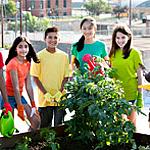Project Learning Essentials
Addressing the need for students to be excited and feel successful about their own learning and to change the pace from the normal day, the AFT makes two major recommendations regarding learning strategies in after-school programs. First, especially when the program is in the same place as regular school, there needs to be a transition between the more formal school day and less formal after-school program that helps students renew their energy and outlook. This can happen briefly and might include exercise, a snack, a game, or personal sharing time. The minutes spent providing a good transition will pay off in better engagement and learning. Second, we recommend project learning because it is a high-engagement, flexible strategy that can bring excitement to learning. Although all activities in an after-school program will not be projects, we recommend that they be used extensively. We highlight projects in five key areas of academic learning: reading, mathematics, science, writing and interdisciplinary. While each of these disciplines may be the prime focus of a project, they are seldom isolated in life and other areas of students’ learning—from geography to the arts—can and should be integrated into project design.
There are several project learning practices that have strong similarities to each other but are distinguished from each other in one or more ways.
Project-Based Learning (PBL) is described in PBL handbooks for teachers as centered around “complex tasks, based on challenging questions or problems, that involve students in design, problem solving, decision making or investigative activities; give students the opportunity to work relatively autonomously over extended periods of time, and culminate in realistic products or presentations.” (Jones, Rasmussen and Moffitt; The Buck Institute, 1999; Thomas) Rhem defines PBL as students working “to find meaningful solutions” to problems.
Project approach refers to “a way of teaching and learning that…emphasizes children’s active participation in the planning, development and assessment of their own work; children are encouraged to take initiative and responsibility for the work that is undertaken.” (Katz and Chard) Some say the goals of the project approach are more adult-directed and PBL goals are devised by students.
Service learning combines community service objectives with learning objectives with the intent that the activity change both the recipient and the provider of the service. This is accomplished by combining service tasks with structured opportunities that link the task to self-reflection, self-discovery and the acquisition and comprehension of values, skills and knowledge content. For example, cleaning up a local stream or neighborhood has both scientific and social studies learning connections. The National Commission on Service Learning in 2001 differentiated service learning from volunteerism saying it is “a teaching and learning approach that integrates community service with academic study to enrich learning, teach civic responsibility and strengthen communities.” Service to the elderly or needy creates civic awareness and can develop a sense of responsibility.
In-depth investigations, applications that result in products or performances and service projects are all activities that can engage students in worthwhile endeavors that motivate them, connect to life and lead to increased learning.
The Buck Institute (Project-Based Learning Handbook, 2003) speaks of project-based learning as an evolving practice and proposed these criteria as distinguishing outstanding projects for middle and high school students:
- Recognition of students’ inherent drive to learn and the ability to do important work.
- Engagement in central concepts and principles of a discipline.
- Involvement of students in exploring important issues or topics.
- Require use of tools and skills such as technology.
- Specify products that solve problems, explain dilemmas, or present information generated through investigation, research or reasoning.
- Multiple student products that allow frequent feedback.
- Use performance-based assessments.
- Encourage collaboration.
The Buck Institute says the “driving question” of the project should be tied to standards and should create a need to know the targeted material. Driving questions make the difference between simple engagement and engagement in learning.
Goodwin cites research showing a major shortcoming of many student projects as “doing for the sake of doing.” Goodwin described how students involved in a rocket-building project initially cited the goal as just “to build them and see how high they will go.” After the project was framed around questions of content where students were to determine which of several choices of design would make the rockets go higher or change its trajectory, students showed more learning of the principles of aerodynamics.

